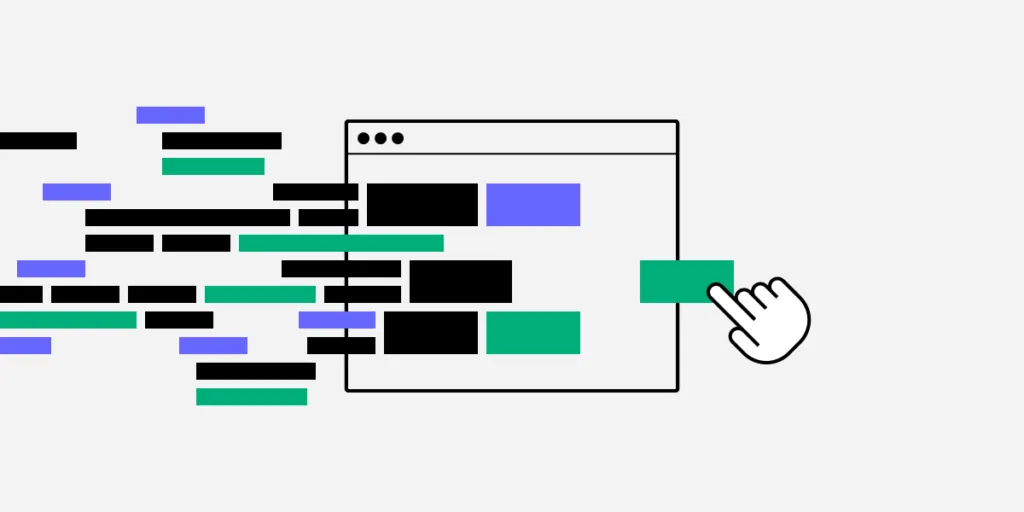Low-Code and No-Code Tools – What Are They?

There is an ever-growing hype around no-code and Low-Code Application Platforms (LCAP). It seems like every week a new low-code product hits the market. Some low-code products target a specific niche, while others work on solutions to eliminate the necessity for coding for a broad spectrum of apps, software, and tools.
The beautiful thing about low-code and no-code development is that it makes building apps and tools more accessible, especially for young entrepreneurs with a big idea and little or no capital.
Many LCAPs allow users to integrate with APIs and infrastructure architecture like Google’s Firebase, enabling companies to build affordable apps and plugins for existing software.
Low code development is also beneficial for UX research and testing. UX designers can create fully functioning prototypes using an LCAP to conduct better user tests before handing designs to engineering teams. This type of low-code workflow could save significant time and money when shipping new products or features.
Low Code vs. No Code – What’s the Difference?
To most people, low-code and no-code development are interchangeable terms meaning the same thing. Most development tools that claim to be no code still allow users to insert some code (usually CSS) for customization, which essentially makes them low code.
The most common and widely accepted term is low code (sometimes Low-Code Application Platforms – LCAP), which refers to low code and no-code development environments.
Still, there are a few subtle differences between low code and no code.
No-Code Application Platform
No-code builders usually come with pre-built templates where users can only change logos, images, and text.
These no-code platforms also allow users to connect to simple databases like Google Sheets or Airtable. No-code development is highly accessible because it enables users with no technical skills to build a functioning app.
Low-Code Application Platform
Low-code builders might also provide users with templates but allow for more customization, like editing page/column layout, adding CSS or Javascript, and connecting APIs.
Low-code platforms might also allow users to connect to more technical databases like Google’s Firebase, Parse, or AWS Amplify.
Many enterprise applications like SAP and Salesforce provide low-code tools so that businesses can build apps to integrate with their software.
How Does Low-Code Development Work?
Low-code platforms typically use a drag-and-drop builder to place elements on the page of an app (mobile, desktop, wearable device) or website. These elements include things like text, images, buttons, navigation, etc. Within each of these elements, users can also pull data from a database, create actions and animations, and more.
Each element is effectively a widget that the low-code platform uses to compile an app or website. Some low-code platforms offer hosting options, which means the user doesn’t have to worry about exporting the code and finding an appropriate hosting environment.
Low-Code in the Design Process
Low-code is fast becoming an essential tool in the design process too. Let’s start with the fact that if a design tool is code-based, not image-based, then the built prototype behaves much closer to the end-product and the interactions can get extremely realistic.
Another perk of low-code design tools is that they can empower whole product teams. Low-code design software makes it easy for product teams with little or no design experience to build products and interfaces with design libraries composed by the UX team.
A perfect example of this is UXPin Merge. Designers can use Merge to import ready UI code components to UXPin and design with them right away. Those ready elements can come from developers’ Git repositories or Storybook.
Product teams can then use those components to design new products and user interfaces. The best part is that the interactions are already there, so the prototype that teams build is high-fidelity and aligned with all the company’s standards.
Because team members use production-ready components, the engineering team can build the final product much faster.
Check out how low-code compares to traditional design and development process in this blog post.
Low-Code Product Design from PayPal DesignOps 2.0
A fantastic example of low-code product design in practice is PayPal’s DesignOps 2.0. Using UXPin Merge, PayPal’s UX designers and developers built a design library of 60+ components for product teams to work with.
This code-based design library allows PayPal’s product teams to build products with minimal input from the UX team. The engineering process is also much faster, with developers completing more than 80 percent of product development work without assistance from the UX team.
Low-Code Development Benefits
The most significant advantages of low-code development are speed and accessibility. Anyone can turn an idea into a workable app, often within a few hours.
Here is a closer look at the benefits of low-code development:
- Speed – Low-code development allows teams and individuals to build applications fast. Even a simple app can take days for engineers to code into a functioning product. More complex apps can take weeks or even months.
- Reduce costs – Engineering is one of the most expensive steps when building apps and websites. Some elements, like security, require specialized engineering skills, which are costly and time-consuming.
- Easy deployment – Low-code platforms often provide one-click deployment and hosting. Hosting an app or website comes with many challenges, especially if you don’t know anything about servers and hosting environments.
- Concept testing – Low-code platforms are fantastic for startups to build a cheap product to test a new concept or idea. A successful proof of concept could help startups secure crucial seed-stage funding. Established companies might use a low-code platform to build a new service, plugin, or add-on to test before investing in development.
Disadvantages of Low-Code Development
While there are many advantages to low-code platforms, there are several disadvantages you might want to consider.
- Scalability – While low-code platforms are excellent for proof of concept, these apps aren’t scalable because they are confined to the platform’s limits. Still, once your app starts producing revenue, you can invest in hiring developers and come up with a scalable solution.
- Limited innovation – Low-code platforms also have a significant limitation on innovation. Again, you have to work within the confines of the platform you’re working with and, therefore, cannot write potentially innovative code or algorithms.
- Expensive hosting – While it’s cheaper and faster to build low-code applications, hosting on low-code platforms offer is exponentially more expensive than a regular hosting service, especially as you scale.
- Performance – There are a couple of factors where low-code development can negatively impact performance. Firstly, because these systems provide a one-size-fits-all solution, it’s likely that there will be lots of redundant and unused code in your final application. Secondly, if you’re using a low-code hosting service, this is likely a shared hosting environment, which is not ideal for speed and performance.
- Security – Apps that process sensitive and consumer data might not be secure enough to pass privacy laws in some parts of the world. For example, the EU’s GDPR and California’s CCPA are very strict about managing personal data.
What Can You Build With Low-Code and No-Code Platforms?
Many people are surprised to learn what you can build with low-code application platforms. For example, with a popular LCAP like Bubble, you can create everything from simple APIs to complex social media platforms, SaaS applications, accommodation reservation platforms (like Airbnb), and much more.
Some LCAP platforms even provide the functionality to create Javascript functions, and sophisticated user flows using a drag-and-drop builder.
Custom Software Add-Ons & APIs
Low-code development is perfect for businesses that need a custom add-on to integrate with existing software.
For example, a company can build a low-code app that connects to their accounting software for employees to log their hours. This kind of app isn’t profitable for the company, so spending tens of thousands of dollars on a custom app doesn’t make financial sense.
In the above scenario, someone from the accounts department could build and deploy a low-code app that works precisely how they want it within a day.
A perfect example of this is Zoho Creator, a low-code app builder that allows companies to build native iOS & Android apps that integrate with their current systems.
SaaS products
There are a growing number of startups building simple SaaS products using low-code platforms. Because these startups don’t have to rely on designers and engineers, they can keep overheads low and scale fast.
Education
Low-code is a perfect solution for building educational tools and apps. These apps could be as simple as capturing new student applications to customized virtual classrooms where students can watch videos, submit homework, interact with classmates, download course notes, receive report cards, and much more.
These are just a few examples of low-code applications, but the use cases can be exhaustive, especially when looking at the potential for cash-strapped developing nations seeking to digitize systems for essential services.
Will Low-Code Replace Developers?
While there will always be a need for developers, low-code application platforms are the future of app development.
The LCAP industry is moving fast. It’s creating new opportunities for startups while allowing established companies the ability to upgrade and improve legacy systems.
According to Gartner, an S&P 500 research and advisory company, “By 2023, over 50% of medium to large enterprises will have adopted an LCAP as one of their strategic application platforms.“
As AI/machine learning technology merges with LCAP, hiring a developer to code an app will be the equivalent of choosing a steam train over the hyperloop. It won’t be long before we see highly complex enterprise applications built using intelligent LCAPs that perform automated upgrades for device compatibility or meet the latest security requirements.
The Future of Low-Code Application Platforms
According to Brandessence Market Research, the low-code market will be worth $65.15 billion by 2027 and $187 billion by 2030.
Software giants like Salesforce, Microsoft, Appian, Oracle, and Agile already have a strong foothold in the low-code market and continually improve these systems to provide their clients with more customization.
It’s likely that instead of building software, these companies will provide the tools for customers to develop their own applications, perfectly adapted to meet their exact business needs.
It is crucial to point out that these low-code application platforms won’t exist without developers and engineers to drive innovation. We’ll be confined to the limitations of low-code applications, even those powered by AI.
Low-code won’t necessarily replace developers but instead, change the systems and tools engineering teams build.
If you want to connect design and development using low-code platforms that anyone in a product team can use, try a free trial of UXPin with Storybook integration. Experience the power of code-based design tools to build digital products faster.

